Maximo Vs. Army of Zin
Heroic chest-hunting and sword-wielding friend of the Grim Reaper, Maximo returns.
Sometimes, the best games are the ones you spend the most time shouting at. Maximo was a lot like that, blending hackandslash third person combat with basic, enjoyable platform game design and wrapping it in a sometimes-impenetrable blanket of difficulty. For those who took to it, it remains one of Capcom's biggest triumphs on the current generation of consoles - an ideal realisation of Ghosts'n'Goblins in 3D. For those who couldn't get past its irksome camera issues and the consistently unforgiving design, it ranks as one of the developer's least enjoyable releases.
The sequel, Maximo Vs. Army of Zin, is equally likely to polarise opinion, but Capcom has clearly acknowledged negative feedback aimed at the first game by splitting the challenge between Normal and Hard difficulty levels, tweaking the camera system and introducing the ability to hang onto platforms when a jump falls short. Otherwise though, apart from sharper visuals and a heavier emphasis on the hackandslash combat, it's almost identical in design to the first game.
Robot wars
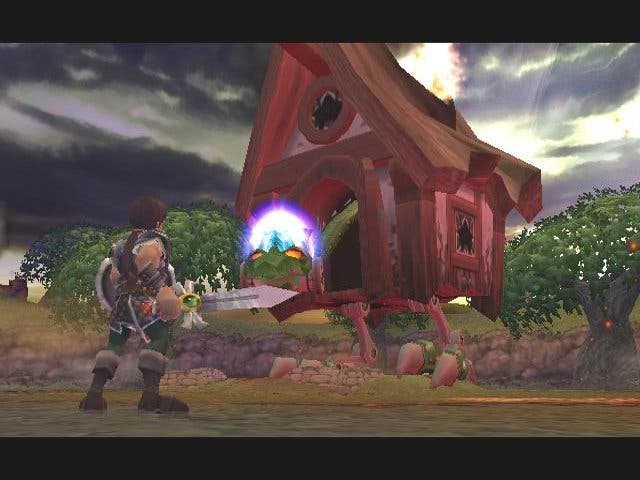
Army of Zin picks up where the original left off, as Maximo and the Grim Reaper's continued search for Sophia leads them to discover that villages are being terrorised by mechanical monstrosities known as Zin, powered by crushed and imprisoned human souls, despite the valiant Lord Hawkmoor's best efforts hundreds of years ago to incarcerate them forever in his castle vault. Following a dramatic intro sequence, Maximo sets off with Grim's help to find the cause of the Zin menace, put it out of business and perhaps discover the resting place - or mechanical prison - of Sophia's wayward soul.
The first thing that veterans will come to appreciate is the game's increased emphasis on combat, which now feels a lot closer to the mechanics of Devil May Cry and Onimusha, measuring hit counts and rating attacks. Players will discover Maximo has a more complete range of attacks, which can be intuitively built into multi-hit combos, and with each fallen soldier of Zin Maximo inherits another human soul, which helps bolster his Grim meter - another new addition.
The Grim meter - a key benefit of Maximo's grisly, darkly humorous relationship with Death - allows him to summon the immensely powerful be-scythed reaper for short periods of time, often allowing him to rescue a hair-raising situation with a burst of undead intervention. Amongst other things, Maximo can even buy an increased Grim meter capacity from a travelling peddler - if he can first rescue him from the clutches of the marauding Zin.
Metal arms
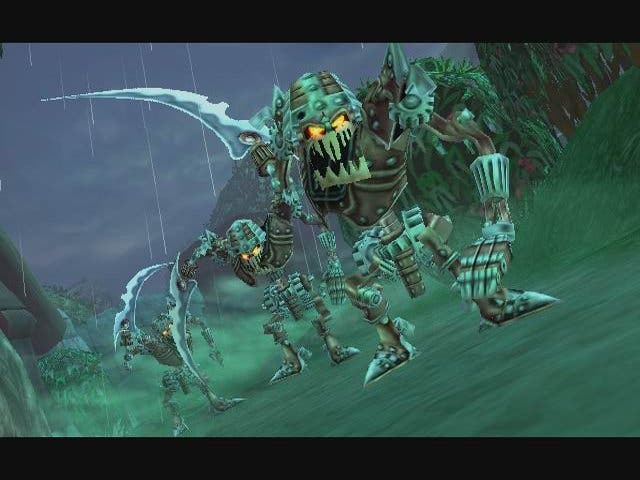
Saving villagers, peddlers and other wayward folk is a recurring theme, and by talking to rescued citizens afterward Maximo is often rewarded with items like coins, health boosts and of course keys. Keys and the chests they unlock, as veterans will no doubt agree, form the basis of what makes Maximo a less than straightforward platform hackandslash. In addition to navigating tricky platform sections and fending off brutal fight sequences, he also gets to seek out locked chests for extra rewards. These rarely turn out to be anything more significant than extra loot or armour, but these bonuses are still compulsively attractive to the player, despite the risk of death often involved in heading back through tricky platform sections to unlock them. Collecting everything is an integral part of playing both Maximo titles, even though technically it's perfectly possible to ignore every single one and leave every single villager to die...
Apart from health items - like suits of armour, which represent a single bar of health, and tankards that refill single bars - rescued peddlers also give Maximo the chance to buy new equipment, like armoured boxer shorts (increasing his health capacity to four bars), and shields which can be used to attract treasure and souls, and sense hidden chests using the rumble function, while peddlers also offer the chance to purchase new fighting skills, from spin attacks and repeated stabbing motions to more violent abstractions.
Coupled with new swords and hammers, which can be found at intervals throughout the game, it's a veritable arsenal to be reckoned with, and offers plenty of different approaches to match against individual enemies - something that becomes key to success, much as it did in the Onimusha series. Weapons-wise, the ice hammer is a personal favourite, its slower swing more than compensated for when it freezes enemies, allowing the player to dodge blows more easily and build combos in a similar way to the hideously underrated Viewtiful Joe.
Candid camera
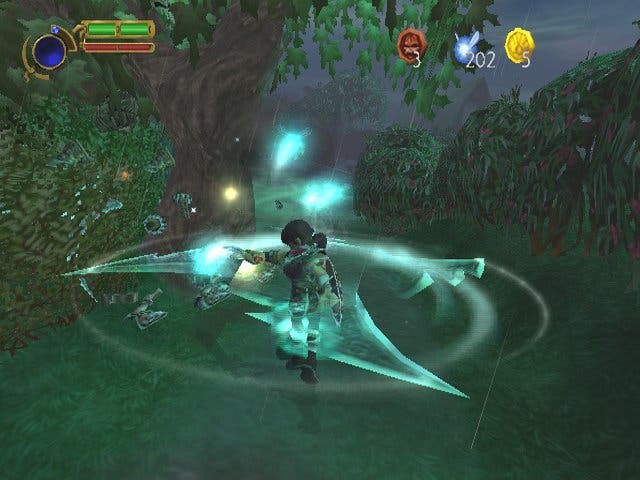
Unfortunately, the quality of the combat is sometimes obscured by the Game Over screen. Problems with the camera are not entirely gone, and it sometimes has trouble with complex platform sections - notably late on in underground caves when buzzing airborne enemies posed a problem for me [and me, when Mugsimo's fists of fury pounded exasperated onto the table, and sent a cup of tea flying - worried Ed], and the camera actually wound up caught under a series of narrow cobwebs, looking up at our hero's feet as he blindly fought off their advances. Although Army of Zin is certainly a more forgiving game than the original Maximo, it's still eminently possible to wind up dead on account of the camera - whether it's because you hadn't centred it with the right analogue stick or L1 recently and were hit from off-screen, or simply because it swept round at precisely the wrong time and left you tumbling into a chasm.
As with the original game, the lives system is based around Death Coins. You can restart a level from one of the reasonably spaced continue points as long as you have Death Coins, which can be found in tricky to reach places and bought from the peddler. When your supply of Death Coins runs dry, it's Game Over, and you'll have to start the whole level again, which can be maddeningly frustrating if you've just lost 25 minutes of painstaking and difficult progress. That said, while the original sometimes put mountains in your path with nary a piece of string to tether yourself, Army of Zin rarely becomes as impassable - even dying at the end of a particularly long level as I sometimes did was never enough to put me off completely, and returning to the game a day or so later is often the key.
Brief and hard
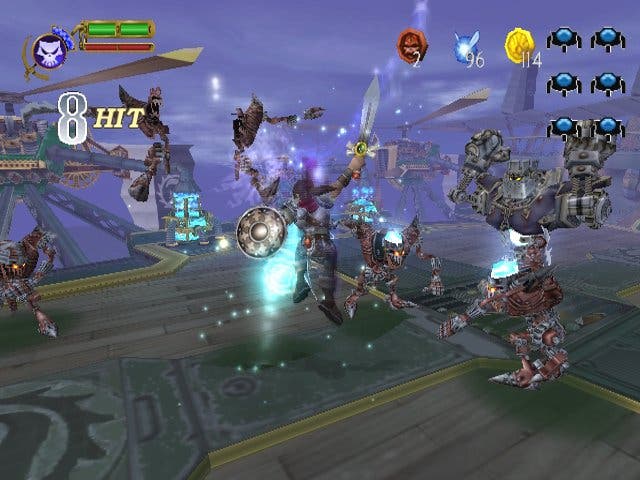
Maximo's newfound ability to latch onto platforms as he falls past them is another boon, and even goes some way to eliminating camera-related deaths, as our shiny hero digs his sword or hammer into most platforms if he doesn't quite make a jump and finds himself sliding into an abyss. It's a good system, and you're generally out of harm's way when you're hanging there, too. The new Grim meter also plays a part in warding off frustration, allowing you to smash up a huge crop of Zin when the going gets tough without having to pick your way through manually. Particularly useful against latter stage enemies - like the scorpion bastards who grab your head and then get nasty, morphing into larger beasts equipped with purple projectiles, or the projectile fist robots and their fiery cousins - and a godsend when you're low on health without a chest or peddler in sight.
Saving the game is no longer a recipe for bankruptcy either. Levels are accessed from a central map screen, and as long as you're there you can just hit R1 to bring up a save screen and record your progress for nought, instead of having to spend coins as in the first game. It means less risk-taking and less frustration.
As such, the biggest complaint levelled at the original game is much less valid here. Those who gave up when faced with replaying an entire unforgiving level may well find Army of Zin a more palatable experience. Unquestionably it's more of a challenge than most games, but it's been pared down a bit. Normal difficulty level is hard, but definitely completable for anybody with enough skill to conquer a Jak, Ratchet or Mario game, while Hard is for the people who didn't complain about the difficulty level in the first place. In other words, it's still not as ridiculously punishing as Ghosts'n'Goblins, but it's still quite harsh at intervals. Some sections really caused problems for me, even though my desire to continue overcame regular expulsions of flaming profanity. Overall I was left with the feeling that some sections in Jak II were much harder and more frustrating than anything I encountered in Maximo Vs. Army of Zin.
Army of chests
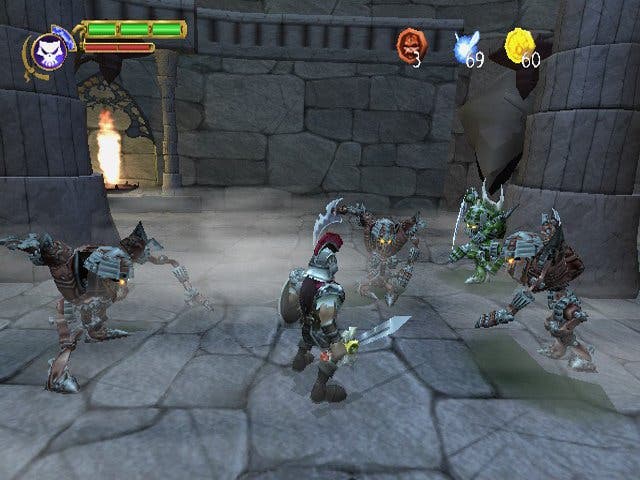
On the other end of the argument, the tweaked design is now even more compelling than the original. It's the same sort of design which infuses the same irrational compulsion to collect every chest no matter whether it'll mean redoing that risky jump, and level design is much more imaginative, too, with some neat ideas that haven't made it into rival platformers brushing shoulders with trusty old devices (like the old "activate/hit three things in quick succession to open a door" or "take on waves of enemies in one spot" ploys) to satisfying effect. It rewards you for keeping an eye on the side of the road, too, catching your attention with level-specific items like movable blocks that you can use to reach higher platforms, found suspended in cobwebs on the ceiling of a caves level.
Indeed, this Maximo actually blends platform and combat trappings with a greater degree of success sometimes than either Jak II or Ratchet & Clank 2, although both of those games managed some truly astonishing visual detail and consistent imagination that Army of Zin lacks. The bosses here are certainly on a par though - imaginative, mechanical beasts like a chaingun-toting chicken stuck in a barn.
Technologically, however, it cannot compete, despite obvious improvements over the original. Personally I still find the visual style extremely alluring, with sharply detailed enemies that splinter, crumple, froth and billow black smoke until they're smashed into harmless shards, and almost Tim Burton-esque environments (little wonder then that Capcom signed The Nightmare Before Christmas), with a tangibly dark and mystical atmosphere reflected in the musical accompaniment. It's less consistent than it should be, however, and looks downright ropey at times - even riffing rather unimaginatively on R&C2/Jak II's industrial environments, albeit with less texture detail - even though it always manages to exude a toon-tainted air of comfort and familiarity.
Straight and narrow

Taken on its own however, there is much to commend about the game's deceptively derivative design. It's not afraid to be linear, for a start. You will soon grow to care about which abilities you can afford to buy, and which weapon to equip in a certain area, but your path is never blocked by the lack of an upgrade, and it's not the sort of game where you gain an ability then find a readymade excuse to use it located out of the way in an earlier level. While this does draw something away from the game's replay value, it never dilutes its emphasis, whereas some sprawling non-linear games of the same ilk can seem incredibly imposing when you first unlock that second level sword.
Ultimately though, whereas Maximo was remembered, loved and often hated for its imposing difficulty level, Army of Zin is due another, separate slap for being a bit on the short side. I finished it in, according to the save screen clock, just under four hours, but realistically factoring in having to replay sections post-Game Over screen, and the sheer effort involved in conquering the final boss alone (easily the hardest bit of the game to my mind), it's going to wind up in the five-to-six hour pile for most people. That's playing every level to a 90 per cent or greater standard, and "mastering" (scoring 100 per cent) a handful.
Sadly the rewards for your efforts seem to pale in comparison to the effort involved - rescued peddlers and villagers throw up keys and hint scrolls and other items, which are key to getting a good percentage of the treasure chests and unlocking bonus artwork, but neither is a huge incentive compared to some of the things Capcom has put in other titles recently. Although it's certainly true that you'll garner the most satisfaction playing it thoroughly, replay value is also debateable. Personally I doubt many gamers will finish the Normal mode and move onto tackle Hard, while getting 100 per cent is often difficult under the best of circumstances, and much harder on the more frustrating levels. In short, while there are things to do for those in need of replay value, it's a game that you probably won't end up replaying as much as you would the likes of Mario 64 or the original Jak & Daxter.
Zintillating
For fans of the first game, Maximo Vs. Army of Zin is a must-have, and if you like platform games with a slant towards combat then this is also an ideal purchase. Coming to it afresh isn't much of a concern either - there's a story, and you may care what happens, but it's really about the experience rather than the amateur dramatics. But while Maximo may find a new audience thanks to this refined adventure, it still presents many of the same problems, and history will probably remember it the same way. For me, then, it's one of Capcom's best games in ages. For others, it could be one of the worst. Give it a go and see how you feel about it.

